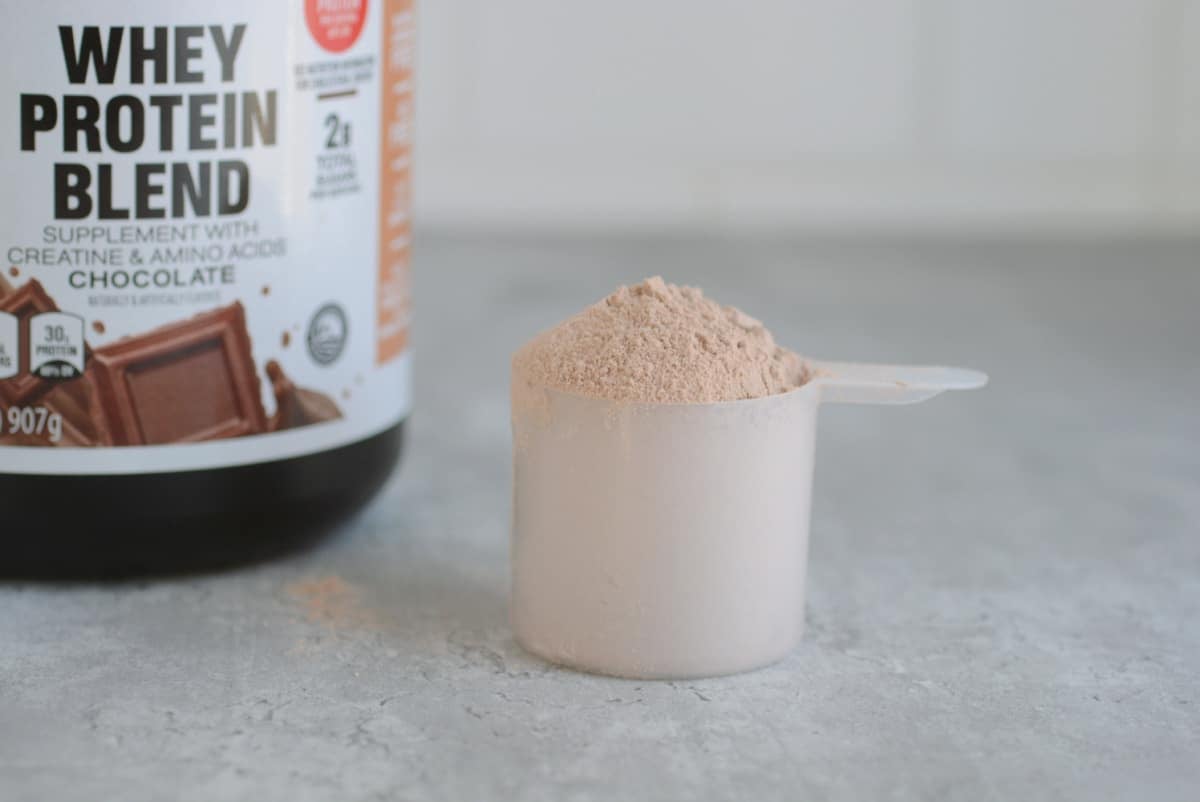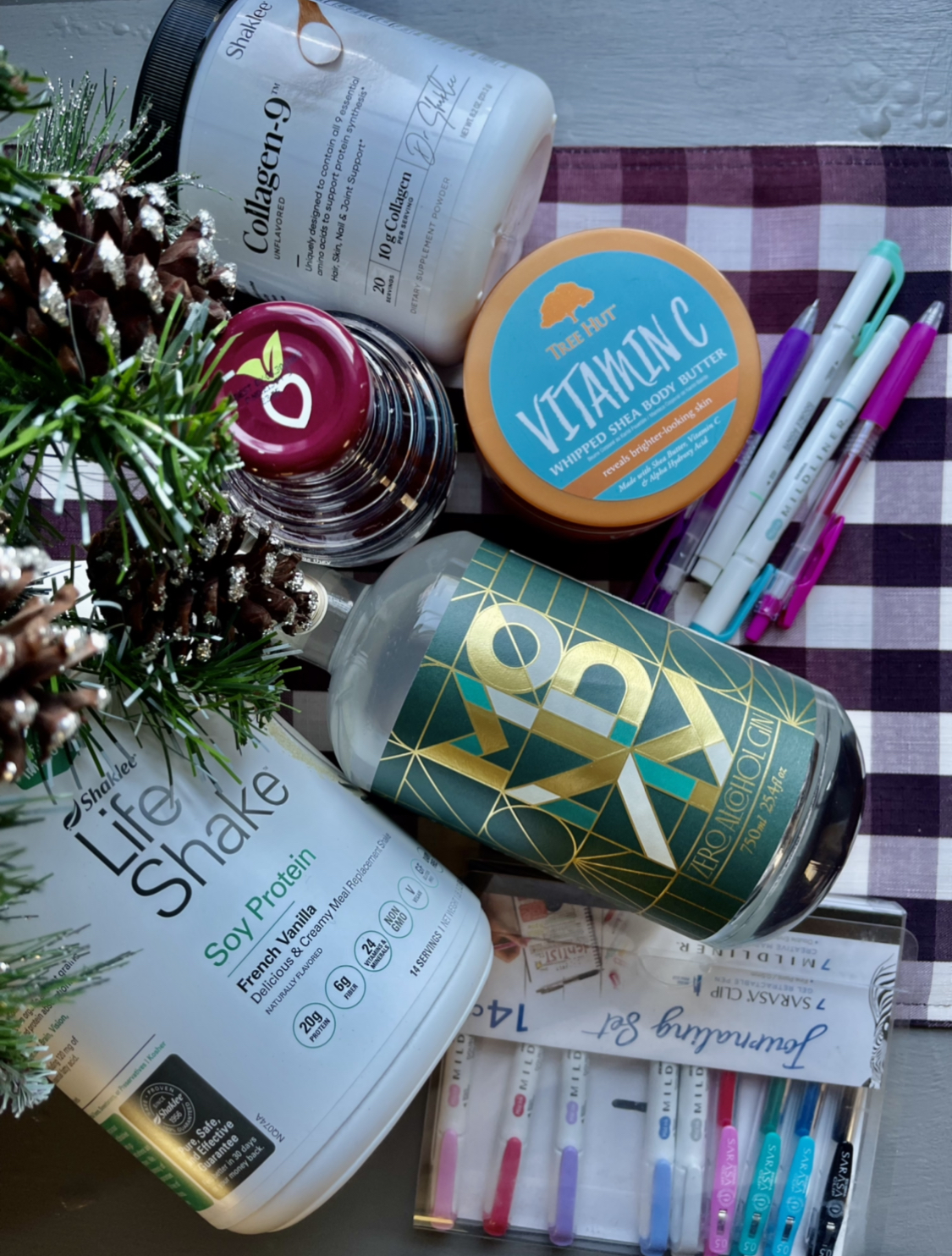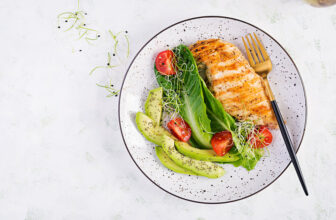
[ad_1]
Inside: If your teen is asking for protein powder–or you’re wondering whether it could help your picky eater–here are the facts you should know.

Quick Takes
- Protein powder is generally safe for kids and teens–with a few important cautions.
- Protein powder is a convenient source of protein, but there are lots of other ways to get protein.
- Your kid is probably getting enough protein, but there are some groups who may not be.
- More protein doesn’t equal bigger muscles.
When my teenager brought home a giant tub of protein powder and parked it on the kitchen counter, I felt a bit uneasy.
As a mom, I knew it was normal, especially for a teen boy with a newfound interest in lifting weights.
But I’m also a registered dietitian with a “food first” mindset. So I wasn’t crazy about a powder with a long list of ingredients.
If you’re feeling iffy about protein powder–or on the flipside, wondering if it might be exactly what your kid needs–I dug in to the facts and went to sports nutrition experts for answers to your biggest questions.
What is protein powder?
Protein powder is made from protein from dairy (whey or casein), egg, or plants such as soy, pea, and even hemp. The protein can be in a few different forms, such as “protein isolate”, “protein concentrate”, or “protein hydrolysates”; these are variations of how much processing the protein has undergone.
Milk, egg, and soy proteins are all “complete” proteins, meaning they have all the essential amino acids we need to get from food. Plant proteins like brown rice and hemp are sometimes combined together in a powder to form a more complete protein.
Whey protein is one of the most common ones you’ll see. It’s quickly absorbed and used by the body.
Protein powder can be mixed with water or milk (dairy or non-dairy) to make a protein drink or added into recipes to boost the protein.
YOU MIGHT ALSO LIKE: Energy Drinks & Kids: 10 Things Every Parent Should Know


For years, protein powder was mostly used by bodybuilders. But today, protein supplements (like powders) are part of a billion-dollar industry–and growing. According to recent research, about 55 percent of adolescent boys and 33 percent of girls reported using protein powders and shakes. In another study, about half of teen athletes who reported using protein supplements said coaches were the ones who recommended it.
How is protein powder helpful?
Protein powder is a quick way to make a high-protein drink or to boost protein in things like smoothies and pancakes. a scoop of protein powder can contain anywhere from 10-30 grams of protein.
For reference, here’s how much protein (at minimum) kids should get per day:
- Ages 9-13: 34 grams
- Ages 14-18: 46 grams (girls), 52 grams (boys)
And here’s how much they’re typically getting on a daily basis, according to government surveys:
- Ages 6-11: 61 grams (girls), 69 grams (boys)
- Ages 12-19: 62 grams (girls), 86 grams (boys)
YOU MIGHT ALSO LIKE: How Much Protein Does Your Kid Need? See age-by-age graphics with photos.
It’s clearly not hard to meet those minimum protein requirements. Protein is found in lots of foods (beyond meat).
But some kids may not be getting enough protein and might benefit from a powder. Your child’s pediatrician (or, ideally, a pediatric dietitian) can hep you determine this. These groups include:
- Extremely picky eaters who eat very few foods
- Kids and teens who are underweight
- Kids and teens who follow a vegetarian or vegan diet and aren’t meeting their protein needs through plant-based sources (ie: they aren’t including foods like beans, lentils, soy, etc.)
- Teens (especially girls) who aren’t meeting protein needs due to a low-calorie diet
- Athletes who have high calorie and nutrient needs and need something easy to supplement their food intake


Do young athletes need more protein?
All kids and teens need protein for the huge amount of growth and change they’re experiencing, because protein is used for a lot of things in the body, like making hormones and enzymes, building muscle tissue and skin, and supporting the immune system.
Teen athletes need even more protein for rebuilding muscles that were damaged during exercise (a normal part of the process), supplying energy for workouts, and building new muscle.
But–and this is important!–extra protein doesn’t add extra muscle. Protein alone does not increase muscle mass. Muscle growth is caused by regularly working the muscles from weight training and other strength-based exercise.
YOU MIGHT ALSO LIKE: Is Your Teen Obsessed With Protein? Here Are The Facts You Should Know.
Is protein powder safe for teens and kids?
Yes–in general, protein powder is typically safe for kids and teens. But there are some important cautions to keep in mind:
- Protein powders are typically highly-processed and can contain ingredients like artificial sweeteners and thickeners (read my advice on highly-processed foods).
- A 2018 report found heavy metals like arsenic and lead in many leading protein powders, including plant-based and organic powders. Other tests done in 2010 by Consumer Reports had similar findings.
- Some protein powders contain very little carbohydrate, which is an important nutrient for kids and teens. If teens combine it with water to make a drink, they’re not getting enough carbohydrate to refuel after workouts.
- Children with peanut allergies may be allergic to pea protein, an ingredient in some plant-based protein powders.
- Protein powder is considered a dietary supplement, just like multivitamins and herbal supplements. That means they aren’t regulated in the same way that foods and drugs are. According to the FDA, they don’t have to be proven safe before they’re marketed. They also don’t have to prove they contain what they claim.


Is protein powder healthy for kids?
It’s a fine source of quick protein, a nutrient that’s important for kids. But it shouldn’t be relied on as a main source of protein.
“Protein powders should not be used to replace the benefits of eating high quality, whole-food sources of protein on a very regular basis,” says Jenna Braddock, MSH, RDN CSSD, CPT, a sports dietitian in St. Augustine Florida who owns MakeHealthyEasy.com for women’s wellness and OffSeasonAthlete.com, a site for teen athletes and their parents. “It should be a supplement to a proper eating rhythm that includes as wide a variety of foods as possible.”
As dietitians, we tell people that it’s best to get nutrients from food when possible versus a supplement. That’s because it’s the interaction of ALL the components of a food that work together for health benefits, not one isolated nutrient like protein.
For example, edamame contains protein but also fiber, iron, and B vitamins. Yogurt contains protein, but also calcium and potassium. Those nutrients all work together to support health.
Is it possible to get too much protein?
Yes, especially if someone is regularly using protein powder, protein bars, and consuming lots of protein in their diet.
There are potential risks to excess protein intake. Regularly getting too much protein can be dehydrating, because as protein breaks down, the body excretes one of the waste products in urine. Extra protein the body doesn’t need can also be stored as fat, which can lead to weight gain over time.
What’s the best time to use protein powder?
In general, it’s best to spread out protein intake throughout the day versus taking in big amounts in one meal.
For athletes doing weight lifting and other strength training, having some protein pre-workout is helpful to supply muscles with amino acids and may help reduce muscle damage that happens during exercise, according to Nancy Clark’s Sports Nutrition Guidebook.
Protein is also needed AFTER exercise to repair and rebuild muscles that have been taxed during a workout–ideally a protein-carb combo in the first 30-45 minutes after a workout.
How much protein do teens need after exercise? According to Clark’s book, here’s a calculation for the amount of protein that optimizes muscle building: 0.12-0.15 grams of protein per pound of body weight within the first two hours after weight training.
For that 130-pound teenager, it’s about 16-20 grams of protein. Most protein powder is well above that. Or teens can get that with two eggs and a piece of toast or a cup of Greek yogurt with berries. There’s some evidence the body can’t use more than about 25 grams of protein at one time to build muscle.


What’s the best protein powder for teens?
There’s not one single protein powder that’s best for kids and teens. But here are some guidelines on choosing one.
How to pick a protein powder:
- Skip unnecessary ingredients. Some may contain ingredients your kid doesn’t need, such as caffeine that could keep them up at night, notes sports nutritionist Marie Spano, MS MS, RD, CSCS, CSSD, ISAK-2, who also suggests avoiding any with added supplements and very high doses of vitamins and minerals. Your kid likely doesn’t need them–and in some cases, those supplement amounts might be too much.
- Consider a protein-only powder. Some powders contain just one ingredient: protein (such as whey, soy, or a mix of plant proteins like pea). “Adding extra vitamins, minerals or ergogenic aids to protein powders runs the risk of getting more than what is needed or even worse, containing a harmful substance,” says Braddock. “In some cases, you don’t know for sure how much of these extra ingredients are actually in the product or if they are a quality addition.”
- Look for third-party testing, such as “NSF Certified Sport” or “Informed Choice” on the label. That way, you’ll know it contains what it claims–and that it’s been tested for banned substances, says Spano.
- Check for sweeteners: If it’s just added it to water, you’ll want a flavored powder. But keep in mind that most are sweetened with zero-calorie sweeteners like stevia and may have an aftertaste. If you opt for a plain powder, you’ll avoid added sweeteners (both regular and artificial) and extra calories, but you’ll need to include other ingredients in the drink for flavor.
- Consider allergies, intolerances, and dietary restrictions. Milk-based powder (whey and casein) may or may not bother people with lactose intolerance. Some people with peanut allergies will also react to pea protein. Vegans will want to avoid whey, casein, and egg-based powders.
- Here are some specific recommendations from registered dietitians:


What can you use instead?
Protein powder is convenient, but it’s not necessary for getting enough protein. There are plenty of whole food sources of protein you can use to make a high-protein drink or shake.
Here are some ingredients to consider using in a shake and the amount of protein they contain:
- Chobani vanilla Greek yogurt: 14 grams per 3/4 cup
- Fairlife ultra-filtered milk: 13 grams per cup
- Dairy milk and soy milk: 8 grams per cup
- Peanut butter: 8 grams per 2 tablespoons
- Non-fat dry milk powder: 6 grams per 2 tablespoons
- PB2 peanut powder: 6 grams per 2 tablespoons
For instance, a shake using a cup of Fairlife milk, 1/2 cup Greek yogurt, 2 tablespoons peanut butter, and a banana contains almost 30 grams of protein, a common amount in a serving of protein powder.
What foods contain protein?
Even grains like pasta and vegetables like peas contain protein (here’s a big list of Protein Snacks for Kids) but some particularly rich sources of protein are:
- Meat, poultry, and fish
- Dairy products like milk, yogurt, and cheese
- Soy foods like tofu and edamame
- Beans and lentils


Protein-rich recipes
Here are some protein-rich recipes your kids and teens might like:
What should I tell my teen?
- More protein won’t make your muscles bigger
- You are probably getting enough protein
- Protein shakes are fine, but there are cheaper ways to get protein too
- You need more than protein to stay healthy and strong, and you still need to eat a balanced diet to get the nutrients you need
- A lot of people on social media are giving bad advice about protein and sports nutrition! Follow reputable, trained professionals like sports dietitians such as Marie Spano, who’s great at debunking misinformation, and Jenna Braddock at Off-Season Athlete, who offers advice on topics like creatine, pre-practice snacks, and gaining weight.
More advice on feeding teens
[ad_2]






